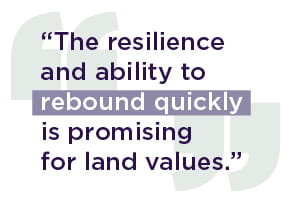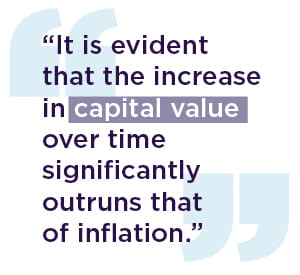In the face of the war in Ukraine and ongoing supply chain issues resulting from the pandemic, we have seen prices rise substantially and impact the UK economy, both directly and indirectly.
The rate of inflation, measured using the Consumer Prices Index (CPI), has reached a 40-year high, rising 9.1% in the 12 months to May 2022. To keep the price of goods and services relatively stable, the UK Government sets a target CPI rate of 2.0%; the Bank of England is responsible for meeting the 2.0% target through monetary policy. CPI inflation was at or below 1% during the first year of the pandemic but has since increased rapidly, triggered predominantly by shocks to the energy market and global supply shortages. This has had a knock-on effect on various aspects of the UK economy, such as transport costs, household energy bills and food production costs.
In periods of inflation, real estate, particularly agricultural land, is considered to be one of safest stores of real value compared to other investment types. Carter Jonas has explored the performance of land values in England and Wales and income from farming against inflation to determine the historical effectiveness of farmland as a means to protect wealth.
Long-term growth in farmland Capital values
Whilst farmland is sometimes thought of by investors as an ‘inflation hedge’, periods of strong land value growth and high inflation do not directly correlate, and many other factors are at play that influence values in the short-term. Nonetheless, land values have historically outperformed inflation over the long-term, and so have the potential to protect investors against a loss of value in real terms (adjusted for inflation).
Although average land values in England and Wales have taken a slight dip over the last five years, the longer-term trend has been strong (see figure 1). Since peaking in 2016, when average values for arable and pasture land reached £10,167 per acre and £7,611 per acre respectively, average land values have fallen by 4.95% overall, equating to an annual change of -1.0% over that period. However, over a 30-year period, land values have grown in nominal terms by a robust 369%, or 5.3% when annualised over that period.
Figure 1
When CPI inflation is accounted for, land values have seen significant growth in real terms (as seen in figure 1), at an annualised rate of 3.1% from 1991 to 2021 (a total of 152.3%), demonstrating a substantial increase for those who have invested over a generation. Against rising inflation, pragmatic investors have been able to use farmland in order to diversify their portfolio and protect wealth, safe in the knowledge that the long-term performance offers a strong value uplift plus a rental income stream.
Undoubtedly, farmland values have experienced periods of growth and decline at varying rates, and the market has been through notable periods of change.
Land values in the 1990s
From the early 1990s, average land values fell slightly as interest rates reached 8.4% in 1991. They soon recovered as wheat prices rose rapidly and increased profitability for cereal farmers. In real terms, values rose by 59.5%, or 4.8% annually, from 1991 to 2001 (figure 1). The Financial Times also cites legal changes to agricultural tenancies in the 1990s as a reason for the increase in values. The Agricultural Tenancies Act (ATA) 1995 provided a flexible framework through farm business tenancies (FBTs), a new type of tenancy structure, making land more attractive to investors.
Land values in the 2000s
In the 2000s, demand became more diverse, and values became less dependent on productivity. For example, according to data from Farmers Weekly, lifestyle buyers purchased 45% of all agricultural land in 2003. Typically, lifestyle buyers are more bullish and, due to buying quality holdings at premium prices, push values ahead of where farmers are often willing to pay. Other than a slight dip in 2009, rising inflation and a steep fall in economic growth during the Global Financial Crisis drove demand for farmland by investors looking for relative safe haven assets (figure 1). Even when the housing market crashed, the farmland market held strong. Between 2002 and 2015, average farmland values in real terms increased by a healthy 95.9%, or 5.3% when annualised.
Land values 2016 to 2020
Prices fell between 2016 and 2020, with Brexit and subsidy uncertainties creating more hesitancy amongst buyers (figure 1). Considering the tough market conditions, values held up remarkably well and only suffered modest falls. Since then, there has been more confidence in the market and increased demand coming from new types of buyers, creating a new era of structural change. Although real farmland values have fallen by a total of 14.2% in the last five years, they have trended upwards over a longer timeframe and weathered the variability in inflation rates. The resilience and ability to rebound quickly is promising for land values in the face of the current high inflation rates and low economic growth.
Land values vs alternative investments
Exploring the change in farmland values compared to other common, tangible assets helps us to understand how different investment types perform. Over a 30-year period, equities (using the FTSE All Share index), gold, residential property and average land values have all grown at a faster rate than CPI Inflation. MSCI All Property capital growth, which is an accumulation of retail, office, industrial and hotel indices and 10-year UK Government Bonds were the only asset types researched that had grown at a slower rate than inflation.
Figure 2
The stability of different commodities and assets varies depending on the level of risk associated with it and whether it is income-producing. While UK Government Bonds (GILTS) are typically a low-risk investment and equities are high-risk and particularly volatile, real estate can be found in between.
Agricultural land, when held in whole or in part as an investment, can yield steady rental income on an array of tenancies, such as leases for agricultural purposes, energy schemes or sporting. Particularly, agricultural landowners are increasingly exploring means to diversify their income by introducing complementary income streams. This is likely to increase further following substantial changes to agricultural support. Incorporating land income returns into this research is likely to show that farmland can generate total returns even further above the rate of inflation if rented and managed, pushing values up even further. Yet, even when income-producing elements of farmland are ignored, it is evident that the increase in capital value over time significantly outruns that of inflation.
Residential rental incomes can respond to market conditions quickly and adjust to inflation due to traditionally having shorter lease terms. Coupled with beneficial supply and demand dynamics, this has ensured that the residential property market has performed remarkable well since 1991.
Looking at figure 2, other assets are exposed to inflationary pressures, such as the equities market or MSCI All Property (which encompasses commercial, residential and hospitality properties) which have seen declines in capital value in periods of high inflation, such as in 2008 and 2011. Yet, non-incoming producing assets, such as gold, are less sensitive. Gold’s lack of income protects investors against the impact of inflation on returns and instead has an appeal of solely a ‘growth asset’.
On a shorter-term basis, farmland values have not performed as strongly, with the 10-year annualised growth at 0.5%. In contrast, the 10-year annualised growth of MSCI All Property was 2.6% in that period, and the FTSE All Share saw a 3.94% annualised increase. In order to generate wealth preservation benefits, farmland does experience some level of volatility but, when held over a longer period, offers greater capital growth than many other investment types.
Short-term influences on land values
While non-farming investors may be more concerned about capital and rental growth, the value of land for farmers hinges, in part, on profitability. Widening profit margins, resulting from an increase in productivity and output prices, create positive sentiment around agricultural land, consequently creating demand and boosting its value. However, in the short-term we are seeing a huge increase in input costs which is outstripping what farms can earn from their land.
The forces behind inflation may create an imbalance between input and output prices and put pressure on farming finances. While high input prices have historically been mitigated by high output prices, the current geopolitical conditions pose huge challenges for farmers and their businesses. In particular, the UK is a net importer of energy and fertilisers, the prices of which have rocketed as a result of the war in Ukraine. According to data from AHDB, the price of fertiliser has grown by 151.8% in the 12 months to May 2022. Likewise, crude oil has seen an annual growth rate of 70.2% and red diesel has increased by 71.6%. In contrast, CPI rose by 9.1% in the same period, significantly slower than most commodities.
The price of outputs has also seen volatility, but not all outputs have increased at a rate as fast as inputs. For example, in the 12 months to May 2022, AHDB reports that pork has seen a growth rate of 17.2% overall. Milk prices have risen at a slightly faster, with annual growth at 27.2%. Domestic wheat and oilseed rape prices have fared better with Ukrainian supplies almost wholly removed from the global commodity market. They have increased by 72.0% and 53.0% respectively. But, with output prices largely lagging, there is a short-term and unpredictable disruption to the agricultural world which has the potential to restrict growth in values.
Encouragingly, new opportunities and income streams for landowners, both farming and non-farming, are helping to create optimism and drive prices. The shift in policy from the Basic Payment Scheme to the Environmental Land Management (ELM) scheme places emphasis on environmental outcomes. Likewise, farm incomes can be supplemented through Biodiversity Net Gain (BNG) credits, Nitrate Neutrality credits or carbon sequestration provisions. A new era of structural change has sparked the upsurge of environmental buyers who bring ‘green money’ to the market to offset the effects of development. These emerging natural capital-based income streams will serve to benefit the market and create demand for land and the environmental solutions it can provide.
There has also been a resurgence in ‘lifestyle buyers’ who have put further pressure on demand and caused prices to soar; the UK has seen a 2-year annualised growth rate of 11.4% in lifestyle land values. With an influx of new buyers creating competition in the market and as environmental policies evolve, we can expect land values to push upwards in the near-term and continue their longer-term rate of growth.
The outlook for land values
Over the last 30 years, farmland values have outperformed inflation and grown at a rate that exceeds many other common investments, delivering wealth preservation benefits.
Despite short-term profitability concerns, the outlook for land values is positive. With limited supply of land coming to the market, growing demand from alternative investors and new income stream opportunities, we believe that land prices will, at the least, hold firm with potential to rise in the short- to medium- term. In the longer-term, it will continue its positive trajectory.
History has shown that land is a safe store of value for investors in uncertain times. The costs of fixed rate borrowing have nearly doubled in the last year and, whilst the tax status of agricultural land is constantly in question, demand still exists from investors, farmers and lifestyle buyers. They are all still likely to find themselves competing for farms and estate properties in key areas.
Structural changes in the market create uncertainties, but also opportunities to leverage new types of usage for agricultural land. Diversified estates with multiple income streams and those with scope to develop them will retain high demand. The emerging trend of environmental investors bringing ‘green money’ to the market for carbon offsetting and biodiversity purposes will help uphold the value of secondary land, with developers looking to buy land as a solution to ambitious government and corporate targets.
Over time, the alternative land use markets are likely to flourish. Yet, with food security moving higher up the agenda, the demand for productive arable and pasture land is also unlikely to diminish. As such, land will continue to be an attractive, long-term investment.
Farming grants and subsidies
See more insight and information about other grant funding schemes.







